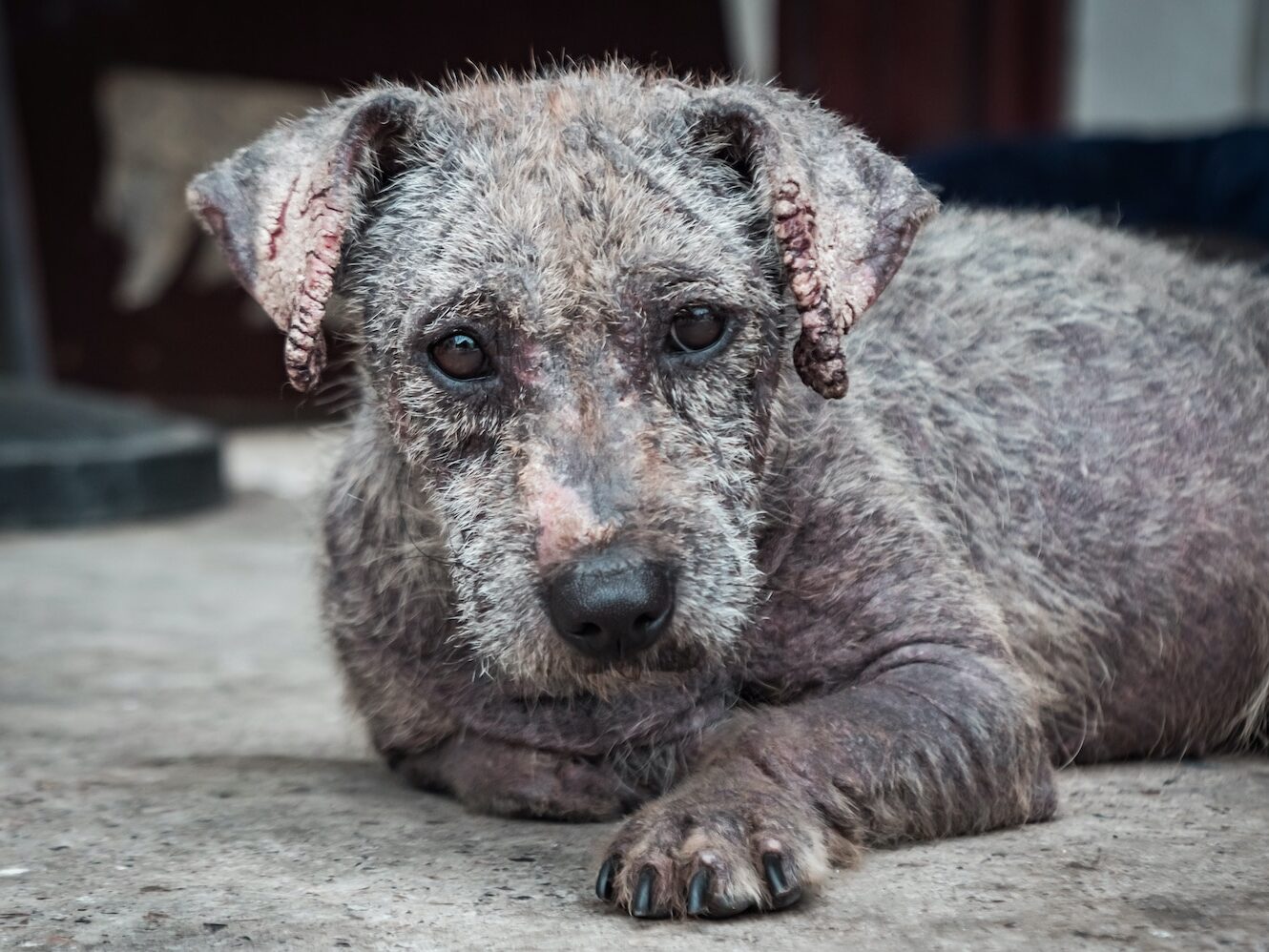Dogs are beloved companions, known for their loyalty and boundless energy. However, just like any other living beings, they can face health challenges too. One such ailment that can affect our furry friends is mange. Mange is a skin condition that can lead to discomfort and distress for dogs.

In this article, we will dive into the world of mange, exploring its causes, symptoms, types, and most importantly, how to provide the best care for your canine companion. Let’s shed light on this often misunderstood issue and empower you with the knowledge to keep your dog healthy and happy.
Table of Contents
What Is Mange In Dogs?: Causes and Symptoms
Mange is a skin disease that affects many dogs, particularly those that have been neglected, abused, or have compromised immune systems. It is caused by many types of microscopic mites that dwell on the skin and hair follicles of the dog. [1]

Mange can result in intense itching, hair loss, skin irritation, and infections, which are common symptoms . It may also have an impact on the dog’s overall health and well-being. Some symptoms can be listed as :
- Severe itching, especially at night
- Hair loss, often in patches
- Skin rash, redness, scaling, or crusts
- Skin lesions, blisters, pustules, or nodules
- Skin thickening, wrinkling, or inflammation
- Foul smell from the skin due to secondary infections
- Fever, weight loss, lethargy, or enlarged lymph nodes
Types Of Mange
Sarcoptic mange and Demodectic mange are the two most common kinds of mange in dogs.
Sarcoptic mange[2], widely known as scabies, is caused by Sarcoptes scabiei mites and is very contagious. Itchy skin, hair loss, and lesions are all frequent symptoms.
“Sarcoptic mange is highly contagious to other dogs and humans” states, Malcolm Weir, DVM, from VCA Hospitals.

Demodectic mange[3] is caused by Demodex canis mites and affects hair, producing loss, redness, and occasionally pustules. Localized cases may resolve on their own, but generalized ones require medical intervention.
According to Malcolm Weir, DVM, from VCA Hospitals, “In some cases, especially dogs with generalized demodectic mange, secondary skin infections complicate the condition and require antibiotic or shampoo therapy.”
Skin scrapings or biopsies can be used to diagnose both types. Medications such as ivermectin, amitraz, moxidectin, or fluralaner are used to treat the condition. Cleaning and vet visits are essential for recuperation.
How to diagnose mange in dogs?
To diagnose mange in dogs, your veterinarian will perform a physical exam and take a sample of your dog’s skin or hair for testing. Here are some steps to diagnose mange in dogs:
- Recognize mange symptoms: Depending on the type of mange, your dog may exhibit various indicators of infection. Sarcoptic mange produces severe itching, hair loss, skin redness, crusts, and scabs, particularly on the ears, elbows, chest, and abdomen. Demodectic mange produces patchy hair loss, minor itching, and secondary skin infections, particularly on the face, legs, and trunk.
- Carry out the pinna-pedal scratch test: This is a simple test for detecting sarcoptic mange in dogs. Gently massage the ear flap of your dog between your fingers and look for a reactionary scratching movement of the hind leg.
If your dog scrapes his or her ear with If your dog scratches its ear with its hind leg, it may have sarcoptic mange. However, this test is not conclusive and may not work for all dogs.

- Take a skin scraping: This is the most common test for diagnosing mange in dogs. Your veterinarian will remove some skin cells from the damaged area using a scalpel blade or a sharp spoon. A microscope will be used to look for mites or their eggs in the sample.
Although this test can detect both sarcoptic and demodectic mange, it is not 100% accurate because some mites may be missed or hidden in deeper layers of the skin.
- Perform cytology: This is a test that can help diagnose secondary infections caused by mange in dogs. Your veterinarian will collect some discharge or fluid from the affected area with a cotton swab or a glass slide.
A dye will be applied to the sample, which will then be inspected under a microscope for bacteria, yeast, or inflammatory cells. This test can aid in determining the kind and severity of the illness as well as guiding treatment.
Prevention of Mange in Dogs
Mange can be prevented by maintaining good hygiene and health for your dog. Some tips include:
- Regularly groom your dog and check for any signs of skin problems.
- Wash your dog’s bedding and toys frequently with hot water and detergent.
- Avoid contact with dogs that have signs of mange or other skin diseases.
- Keep your dog up to date with vaccinations and deworming.
- Feed your dog a balanced and nutritious diet that supports his immune system.
- Consult your veterinarian if you notice any changes in your dog’s skin or behavior.
Mange is a common and treatable condition in dogs that can cause discomfort and distress. By knowing the types, symptoms, diagnosis, and treatment of mange, you can help your dog recover and prevent future outbreaks.
If you suspect that your dog has mange, contact your veterinarian as soon as possible for proper diagnosis and treatment.
Conclusion
Mange in dogs, whether it’s the contagious sarcoptic mange or the non-contagious demodectic mange, can be distressing for both pets and their owners. Recognizing the symptoms and seeking prompt veterinary care is essential to ensure effective treatment and prevent complications.
With proper diagnosis and appropriate medications, mange can be managed, allowing your furry friend to regain their comfort and well-being.
FAQs
1) Can humans get mange from dogs?
No, demodectic mange is not contagious to humans. However, sarcoptic mange can be transmitted from dogs to humans, causing an itchy rash known as scabies. Immediate medical attention is recommended if you suspect scabies.
2)How is mange diagnosed?
Mange is diagnosed through skin scrapings or biopsies, where a veterinarian examines samples under a microscope to identify mites or eggs. Clinical signs, history, and exposure to other infected animals are also considered.
3)Can mange be treated at home?
It’s crucial to consult a veterinarian for proper diagnosis and treatment. While localized demodectic mange in puppies may resolve on its own, other cases require prescribed medications and veterinary guidance for effective management.
4) Is mange preventable?
Maintaining good overall health for your dog can contribute to preventing mange. Regular grooming, a balanced diet, and controlling stress can help keep their immune system strong. Avoiding contact with infected animals also reduces the risk of sarcoptic mange.
5) Can other pets or humans in the household get infected?
In the case of sarcoptic mange, both other pets and humans can potentially get infected. Close contact with the infected dog should be minimized, and any unusual symptoms should be evaluated by a medical professional.
References:
- Demodectic mange in dogs | VCA Animal Hospital | VCA Animal Hospitals. (n.d.). Vca. VCA-Hospitals
- Pin, D., Bensignor, E., Carlotti, D. N., & Cadiergues, M. (2006, October 1). Localised sarcoptic mange in dogs: a retrospective study of 10 cases. Journal of Small Animal Practice. Retrieved August 22, 2023, from NCBI.
- Unsworth, K. (1946). Studies on the clinical and parasitological aspects of canine demodectic mange. Journal of Comparative Pathology and Therapeutics, 56, 114–127, from ScienceDirect.


